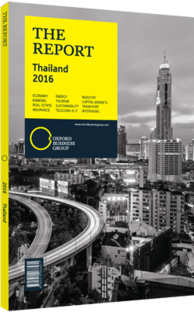Kan Trakulhoon, Chairman of the Management Advisory Committee and Former President, Siam Cement Group: Interview

Interview: Kan Trakulhoon
What is the short-term outlook for domestic demand for cement and building materials?
KAN TRAKULHOON: The growth of the Thai economy has slowed over the past two years due mainly to a lack of external demand as well as low household spending, delayed private investments and obstructed government disbursements. The impact of this was felt in 2014 when demand for cement contracted by -1% year-on-year following growth of 7% in 2013. This contraction was led equally by the government and the residential construction segment, both of which shrank by 1%. The commercial segment grew 1% in contrast to 20% growth in 2013. Demand for building materials has also been slow, on the back of a weak residential market, with the number of new registered homes decreasing by 0.1% in 2014.
That being said, I believe that the domestic cement market will improve in the short term. Growth projections stand at 3% for 2015, and this recovery will continue in 2016, driven largely by government budget disbursements, for large-scale projects in particular. Furthermore, I expect to see the number of private investments growing due to these government projects. The commercial segment in Bangkok and other provinces is also likely to show strong growth within the tourism sector, although the residential market is expected to underperform due to high household debt and low farm incomes affecting demand for building materials. Despite this, new stimulus packages with a special focus on rural areas will stimulate domestic demand by helping low-income earners and expediting local spending.
How are large-scale infrastructure projects across the ASEAN region impacting Thailand’s exports of construction materials?
TRAKULHOON: ASEAN markets represent huge potential for the cement and construction materials industries, and Thai companies are eager to tap into these opportunities. In contrast to the slump in Thailand’s cement market, growth rates in 2014 stood at 11% domestically in Myanmar and Vietnam, 10% in Cambodia, 6% in Laos and 3% in Indonesia. Indonesia and Vietnam in particular show high aggregate domestic demand, and are among the largest markets in ASEAN in terms of population. Meanwhile, Cambodia and Laos are both showing excess demand, and Myanmar has a strong need for imported cement. These signs of growth can be attributed to current spending on infrastructure and construction.
Thailand is positioning itself to take advantage of its membership of the ASEAN Economic Community, stepping in to fulfill what is a rapidly growing demand in the region. Thailand’s exports to ASEAN accounted for 44% of all exports in the first half of the fiscal year 2015. Once a critical mass of exports to a country is reached, the opportunity arises to establish a manufacturing base in that country. Myanmar, for example, is a relatively undeveloped economy with high growth potential, and Thai companies can expect an immediate demand for their products and services, while cheaper daily wages almost guarantee the country will become another production base.
What emphasis is being put on green construction processes and products within the industry?
TRAKULHOON: Green and sustainable development should be conducted throughout the supply chain in order to mitigate potential risks that come with procuring raw materials from suppliers in a market dominated by oligopolies, as well as to mitigate supplier conflicts on environmental and safety laws. What is important to realise is that sustainability and green development represent positive long-term business opportunities rather than simply being compliance issues. For example, in 2014 the sales of our eco-value line products increased by 31%, and these products now account for 31% of our total revenues from sales.
You have reached the limit of premium articles you can view for free.
Choose from the options below to purchase print or digital editions of our Reports. You can also purchase a website subscription giving you unlimited access to all of our Reports online for 12 months.
If you have already purchased this Report or have a website subscription, please login to continue.

